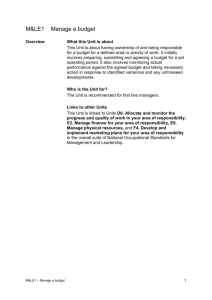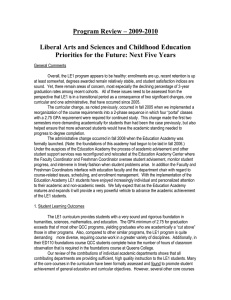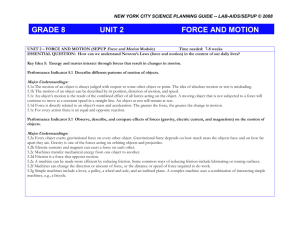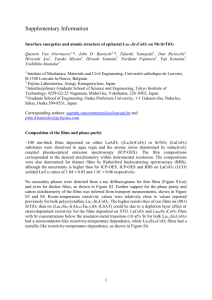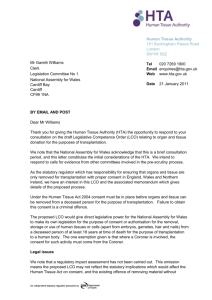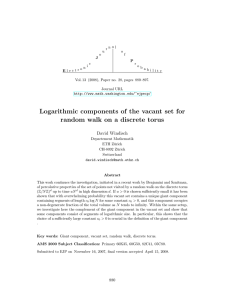UNIT 1 – FORCE AND MOTION (SEPUP Force and
advertisement
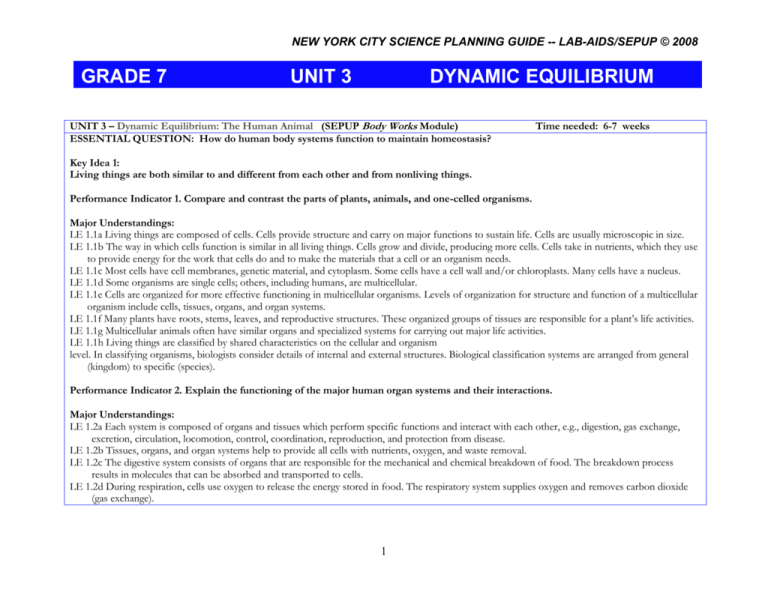
NEW YORK CITY SCIENCE PLANNING GUIDE -- LAB-AIDS/SEPUP © 2008 GRADE 7 UNIT 3 DYNAMIC EQUILIBRIUM UNIT 3 – Dynamic Equilibrium: The Human Animal (SEPUP Body Works Module) ESSENTIAL QUESTION: How do human body systems function to maintain homeostasis? Time needed: 6-7 weeks Key Idea 1: Living things are both similar to and different from each other and from nonliving things. Performance Indicator 1. Compare and contrast the parts of plants, animals, and one-celled organisms. Major Understandings: LE 1.1a Living things are composed of cells. Cells provide structure and carry on major functions to sustain life. Cells are usually microscopic in size. LE 1.1b The way in which cells function is similar in all living things. Cells grow and divide, producing more cells. Cells take in nutrients, which they use to provide energy for the work that cells do and to make the materials that a cell or an organism needs. LE 1.1c Most cells have cell membranes, genetic material, and cytoplasm. Some cells have a cell wall and/or chloroplasts. Many cells have a nucleus. LE 1.1d Some organisms are single cells; others, including humans, are multicellular. LE 1.1e Cells are organized for more effective functioning in multicellular organisms. Levels of organization for structure and function of a multicellular organism include cells, tissues, organs, and organ systems. LE 1.1f Many plants have roots, stems, leaves, and reproductive structures. These organized groups of tissues are responsible for a plant’s life activities. LE 1.1g Multicellular animals often have similar organs and specialized systems for carrying out major life activities. LE 1.1h Living things are classified by shared characteristics on the cellular and organism level. In classifying organisms, biologists consider details of internal and external structures. Biological classification systems are arranged from general (kingdom) to specific (species). Performance Indicator 2. Explain the functioning of the major human organ systems and their interactions. Major Understandings: LE 1.2a Each system is composed of organs and tissues which perform specific functions and interact with each other, e.g., digestion, gas exchange, excretion, circulation, locomotion, control, coordination, reproduction, and protection from disease. LE 1.2b Tissues, organs, and organ systems help to provide all cells with nutrients, oxygen, and waste removal. LE 1.2c The digestive system consists of organs that are responsible for the mechanical and chemical breakdown of food. The breakdown process results in molecules that can be absorbed and transported to cells. LE 1.2d During respiration, cells use oxygen to release the energy stored in food. The respiratory system supplies oxygen and removes carbon dioxide (gas exchange). 1 NEW YORK CITY SCIENCE PLANNING GUIDE -- LAB-AIDS/SEPUP © 2008 GRADE 7 UNIT 3 DYNAMIC EQUILIBRIUM LE 1.2e The excretory system functions in the disposal of dissolved waste molecules, the elimination of liquid and gaseous wastes, and the removal of excess heat energy. LE 1.2f The circulatory system moves substances to and from cells, where they are needed or produced, responding to changing demands. LE 1.2g Locomotion, necessary to escape danger, obtain food and shelter, and reproduce, is accomplished by the interaction of the skeletal and muscular systems, and coordinated by the nervous system. LE 1.2h The nervous and endocrine systems interact to control and coordinate the body’s responses to changes in the environment, and to regulate growth, development, and reproduction. Hormones are chemicals produced by the endocrine system; hormones regulate many body functions. LE 1.2i The male and female reproductive systems are responsible for producing sex cells necessary for the production of offspring. LE 1.2j Disease breaks down the structures or functions of an organism. Some diseases are the result of failures of the system. Other diseases are the result of damage by infection from other organisms (germ theory). Specialized cells protect the body from infectious disease. The chemicals they produce identify and destroy microbes that enter the body. General Skills (from NYS Core Curriculum) GS 1. follow safety procedures in the classroom and laboratory GS 2. safely and accurately use the following measurement tools: metric ruler, balance, stopwatch, graduated cylinder, thermometers, spring scale, voltmeter GS 3. use appropriate units for measured or calculated values GS 4. recognize and analyze patterns and trends GS 5. classify objects according to an established scheme and a student-generated scheme GS 6. develop and use a dichotomous key GS 7. sequence events GS 8. identify cause-and-effect relationships GS 9. use indicators and interpret results Living Environment Skills (from NYS Core Curriculum) LE 1. Manipulate a compound microscope to view microscopic objects LE 2. Determine the size of a microscopic object, using a compound microscope LE 3. Prepare a wet mount slide LE 4. Use appropriate staining techniques LE 5. Design and use a Punnett square or a pedigree chart to predict the probability of certain traits LE 6. Classify living things according to a student-generated scheme and an established scheme LE 7. Interpret and/or illustrate the energy flow in a food chain, energy pyramid, or food web LE 8. Identify pulse points and pulse rates LE 9. Identify structure and function relationships in organisms. 2 NEW YORK CITY SCIENCE PLANNING GUIDE -- LAB-AIDS/SEPUP © 2008 GRADE 7 WEEK 1 11 12 WEEK 2 13 1 14 UNIT 3 DYNAMIC EQUILIBRIUM Title Key Concepts and Processes Advance Prep Notes to teachers Sick Day Students discuss the trade-offs in taking a medication when ill. What’s Happening Inside? Students demonstrate knowledge of and/or learn about human body systems as they develop a three dimensional model of several systems Living with Your Liver Students act out a role play on the function of the liver. Breakdown Students design an experiment to investigate the effect of mechanical breakdown on chemical breakdown during digestion. Evidence, tradeoffs, qualitative, quantitative, placebo copy student sheet Human body systems, organ, structure, function, modeling Need chart paper, markers, roll of plastic wrap; copy student sheets; make demo model Organ, function, liver, regulating internal environment, toxin experimental design, digestive system, mechanical and chemical breakdown, modeling, surface area (optional) Teaching periods1 1 Assessment Alignment to NYS Core Curriculum AQ 2: ET-uet (TG p. a-2) LE1.2j 3-4 LE1.1e, LE1.2a, LE 9 1 antacid tablet containing calcium carbonate (optional); balances (optional); hard candies (optional) 2 Teaching periods are based on a 45-50 minute class period. Times are estimates and actual time needed may vary . 3 LE1.2a, LE1.2b, Procedure: DCI-rdp (TG p. a-3) GI TG (p. a-6) LE1.2c, GS 1 NEW YORK CITY SCIENCE PLANNING GUIDE -- LAB-AIDS/SEPUP © 2008 GRADE 7 15 WEEK 3 16 17 WEEK 4 18 UNIT 3 DYNAMIC EQUILIBRIUM Title Key Concepts and Processes Advance Prep Notes to teachers Digestion—An Absorbing Tale Students read about the function and structures of the human digestive system. Balancing Act Students explore the use of and need for Calories as they design and produce edible energy bars tissue, absorption, nutrients, cross-section (optional) string (optional); copy student sheet Calories, exercise and nutrition, qualitative, quantitative, trade-offs Gas Exchange Students quantitatively measure the amount of carbon dioxide in their exhaled breath by using an indicator to perform a titration. The Circulation Game As a class, students model the transport function of blood as it travels in the human circulatory system. Respiratory system, indicator, control, qualitative, quantitative, range circulatory system, organ, structure, function, modeling Assessment Alignment to NYS Core Curriculum 1-2 AQ 3: UC (TG p. a-4) LE1.1e, LE1.2b, LE1.2c, LE 9 Need multiple food items, measuring spoons, measuring cups, plastic cutlery, sandwich bags; copy student sheets need chart paper, sponge; may need distilled water; 1 bottle of carbonated water (optional) 2-3 Activity: GI (TG p. a-6) AQ 4: ET-uet (TG p. a-2) LE1.1b, GS 1, GS 3 2-3 Procedure: DCI-od (TG p. a-3) LE1.2a, LE1.2b, LE1.2d, GS 3, GS 9 need paper clips or alternative; draw model on ground; road map (optional); drum (optional) 1-2 Activity: GI (TG p. a-6) CM (TG p. a-5) LE1.2a, LE1.2b, LE1.2f 4 Teaching periods1 NEW YORK CITY SCIENCE PLANNING GUIDE -- LAB-AIDS/SEPUP © 2008 GRADE 7 DYNAMIC EQUILIBRIUM Title Key Concepts and Processes 19 Heart-ily Fit Students collect data on their heart rate and recovery times as a quantitative measure of physical fitness. pulse, quantitative, regulate, need calculators; recovery time, range copy student sheet 20 Great-Aunt Lily’s Will After watching other students perform a role play, students decide on the best use of limited funds to fight heart disease and promote public health. Inside A Pump Students explore the role of valves in the heart by using different pumps as potential models. The Heart–A Muscle Students investigate the strength of heart muscle as they attempt to pump water at their resting pulse rate. Heart Parts Students read about the structures and functions of the evidence, trade-offs, heart disease, public health four students prepare to role play for the class; copy student sheet 1-2 heart, structure, function, modeling need sponges, mop; apple (optional) 1-2 heart, structure, function, modeling, muscle, volume need 1-L bottles, sponges, mop; meter sticks (optional) 1-2 heart, valve, atrium, ventricle, artery, vein, capillary copy student sheet; stethoscopes (optional); sheep’s hearts 1-3 21 WEEK 5 UNIT 3 22 23 Advance Prep Notes to teachers 5 Teaching periods1 Assessment 1 Alignment to NYS Core Curriculum LE 8, GS 2 LE1.2j, GS 8 Activity: GI (TG p. a-6) AQ 3: UC (TG p. a-4) LE1.2a, LE 9 LE1.2a, LE1.2f, GS 1 [An optional sheep’s heart dissection is described in the NEW YORK CITY SCIENCE PLANNING GUIDE -- LAB-AIDS/SEPUP © 2008 GRADE 7 Title 24 WEEK 6 25 26 WEEK 7 27 28 human circulatory system. Round and Round Students use pumps to design a working model of the human circulatory system. Healing the Heart Students view a video segment on the history of heart surgery and organ transplants. Heart Sounds After an introduction to heart problems, students listen to normal and abnormal heart sounds. The Pressure’s On Students model the effects of high blood pressure on the circulatory system using clamps with the pump simulation. Heart Problems Students read about the physiological causes of high blood pressure, heart disease, and heart attacks. UNIT 3 Key Concepts and Processes circulatory system, arteries, veins, modeling DYNAMIC EQUILIBRIUM Advance Prep Notes to teachers dissection tools (optional) need 1-L beaker, sponges, mop Teaching periods1 Assessment Alignment to NYS Core Curriculum Teacher’s Guide.] 2-3 AQ 2: UC (TG p. a-4) LE1.2a, LE1.2b, LE1.2f cardiovascular, trade-offs, heart disease, public health, ethics preview & cue video 1 heart rate, valve, atrium, ventricle need audiocassette player 1 arteries, veins, modeling, qualitative, quantitative, blood pressure need 1-L bottles, sponges, mop; copy student sheet 1 LE1.2j, LE 9, GS 2 circulatory system, arteries, veins, coronary arteries, risk factors copy student sheet 1 LE1.2a, LE1.2f, LE1.2j, GS 4, GS 8 6 LE1.2j AQ 4: UC (TG p. a-4) LE1.2j, GS 4 NEW YORK CITY SCIENCE PLANNING GUIDE -- LAB-AIDS/SEPUP © 2008 GRADE 7 Title 29 UNIT 3 Key Concepts and Processes Helping Hearts circulatory system, arteries, After taking a heart risk factors, trade-offs, risk quiz, students voluntary design a public health brochure on a risk factor for heart disease. DYNAMIC EQUILIBRIUM Advance Prep Notes to teachers copy student sheet 7 Teaching periods1 2+ Assessment Alignment to NYS Core Curriculum Activity: UC (TG p. a-4) CM (TG p. a-5) AQ 2: ET-uet (TG p. a-2) LE1.2j, GS 7, GS 8
